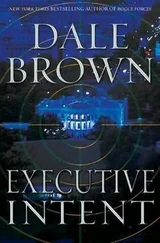“Goose One and Two in the green…nothing from Goose Three…Goose Four…nope, lost that one too,” Jason said. “We lost the two southernmost drones, guys. Keep that in mind—coverage to our south might be poor.” He turned to the twelve commandos in the forward part of the cargo bay, then pointed an armored finger at a man handcuffed to them. “I want him with me as soon as we get in that building,” he said. “If he tries to run, shoot him.”
“Yes, sir,” the team leader responded.
“Five seconds.”
Another severe rumble and scream of metal split the air. “Is this thing going to hold together for that long?” Mike Tesch in CID Three asked.
The pilot didn’t dare try to answer that one. Instead, he shouted, “ Green light! Go! ”
Jason Richter and Jennifer McCracken in CID One and CID Two jumped first. There was no time to practice a good parachute landing fall—students in the U.S. Army Airborne School practiced them for five full days before being allowed to jump from anything higher than a three-foot platform—so Jason’s landing didn’t look much better than the first time he jumped from the Osprey. But Jennifer’s landing looked like she had been jumping from special ops planes all her life. “Good job, Lieutenant,” Jason told her after he picked himself up off the ground. “Done this before, I see.”
“Army Airborne School, class zero-four dash eleven, and Marine Corps Mobile Airborne Training Team certified same year, sir,” she replied. Even in the CID unit, Jason could see the look of confusion in her “body” language. “Are you telling me you’ve never attended jump school, sir? You’ve jumped out of planes twice now and never learned how to land? I’m surprised you haven’t broken every bone in your body, sir.”
“I’ll take that as a compliment, Lieutenant,” Jason said as he checked his systems. “Let’s go.” He and McCracken had jumped on the very outside of the easternmost spoke of the outer buildings surrounding the central Internal Affairs building. Tesch and Dodd had been dropped off on the other side of the complex. As soon as Tesch and Dodd reported they were on the ground and ready, they headed in.
Automatic gunfire from above erupted almost immediately as machine gunners opened fire from atop the administrative buildings. The GUOS drones picked up activity on the far side of the buildings, and the CID units were able to accurately target their backpack grenade launchers and machine guns on those positions—they had no choice but to run away from the gunfire.
As Harry Dodd reached the end of the southwestern admin building, a Humvee with a large missile launcher unit suddenly appeared. “SAM unit!” Dodd shouted. Just as he set his aiming reticle on the vehicle, it launched a missile skyward. “Poppa Bear, missile launch, missile launch! ” he shouted, seconds before ordering his grenade launcher to open fire. Just before his two grenades hit, the Bofors RBS-70 missile streaked away.
But as he watched, several dozen streaks of light and blobs of white-hot energy fanned out across the sky less than a mile away, bright enough to light up the Bosque de Chapultepec for miles around—the CV-22 Osprey ejecting decoy flares. Dodd knew that all of the CV-22’s other countermeasures were active as well—an active missile-tracking laser that blinded an enemy missile’s seeker head, decoy chaff, and electronic radar and laser jammers as well. The RBS-70 missile stayed dead on course, but just for an instant. Moments later Dodd could see the motor exhaust flame wobble, slightly at first and then greater and greater. Seconds later it exploded—and there was no secondary explosion.
“Thanks for the heads-up, Talon,” the assistant flight engineer radioed. “I saw that missile coming up at us and thought it was heading right for the blank spot between my eyes. Good hunting down there.”
The CID units spread out once they reached the central headquarters building, with each CID unit taking a cardinal position. On Jason’s order, Mike Tesch sent two grenade bursts into the front entranceway from forty yards away, blowing the doors open. Seconds later came a murderous burst of heavy machine gun fire, followed by several grenade detonations.
That was the signal to begin the real assault. The other three CID units on the other sides of the building began climbing the outside of the Internal Affairs Ministry. Each CID unit would simply leap up to the windowsill above, pull itself up to the window, jump up to the next window, and continue. When it reached its preplanned floor, it climbed inside. Jennifer McCracken continued up to the roof of the building, where she planted explosives around the base of the antenna tower and blew it apart moments later.
“We lost the microwave datalink and all radio contact, sir,” Deputy Minister Elvarez said. “They probably destroyed the antenna tower on the roof. The secure hardwire lines and circuits are still operational.” He leaned toward Felix Díaz. “The roof of this building is the most vulnerable spot, sir. If they have troops on the roof, it is only a matter of time before they get inside.”
“What is the status of the document destruction?”
“Just started, sir. Magnetic records can be erased in minutes, but the paper documents and any records stored on other than the mainframes and servers will take much longer.” The lights flickered and went out, and this time only the battery-powered standby lights stayed on. “Sir, you will have to evacuate to a secure location, and do it quickly,” Elvarez said urgently. “We may have only moments before this building is overrun.”
Díaz nodded. “All right. The information officers will have to ensure that the data destruction is completed.”
“Yes, sir.” Elvarez picked up a phone and punched in an extension number. “Report…very well, we are on our way.” He hung up the receiver. “We will have to take the stairs because the elevators are out,” he said, “but the tunnel to the Metro system is open and guarded. We have already closed down the number seven and nine lines, and a train is available immediately to take us to the airport. A plane is waiting to get us out of…”
At that moment they heard a loud crash! and the very walls of the command center started to shake. “What in hell…?”
Elvarez studied the readouts on his computer screen, but he didn’t need a computer to tell him that the outer doors to the command center had been blown in. “This way, sir—there’s no time!” he said. “The emergency chute.” He unlocked a cabinet in a corner of the room, moved a hidden lever, then swung the cabinet aside, revealing a hidden doorway. There was a dark hole in the floor, surrounded by what appeared to be a thin, gauzy white material. “This is the emergency fire escape tunnel, sir,” Elvarez said. “The material is fireproof and is designed to slow your body as you slide down. Simply extend your arms slightly to slow yourself down if you feel it necessary, but allow yourself to go all the way down without delay.”
“Where does it lead?”
“It leads to a fire valve inspection room in the underground parking area in the first subfloor,” Elvarez said. “I will go first and secure it.” Elvarez drew a sidearm, removed his shoes, and stuffed them into his pockets, then stepped into the fabric tube and disappeared. “It is safe, sir,” he called from several feet below. “Take off your shoes and follow me.”
The tube was snug but not constricting. All Díaz had to do was to think about making his body narrower and he slid faster, and when he thought he was going too fast, his elbows would unconsciously protrude and slow him down. He heard Elvarez say something, but he was at least a couple floors below him now and it was hard to hear inside the tube.
Читать дальше












